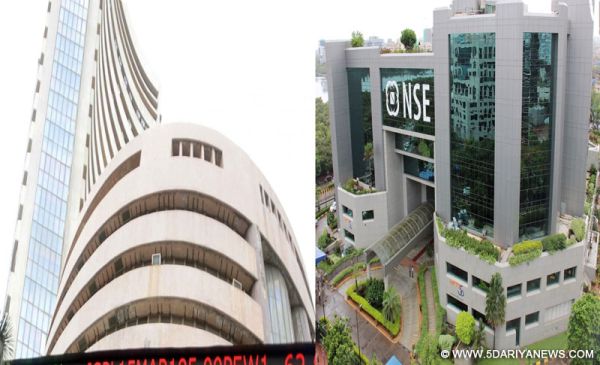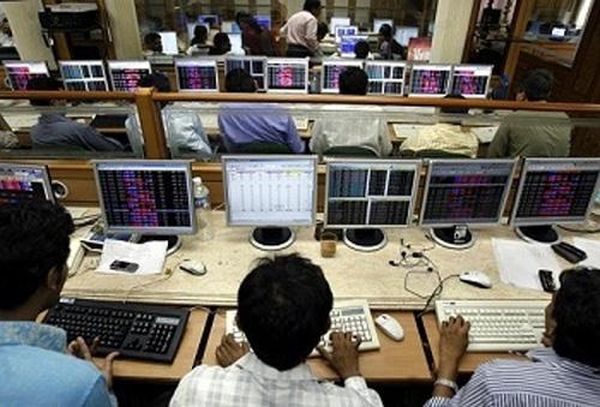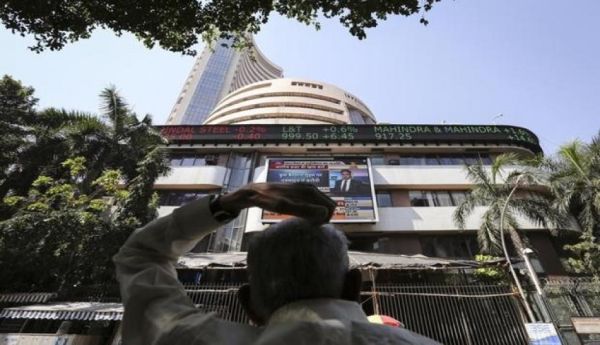
by admin | May 25, 2021 | Banking, Economy, Markets, News
 Mumbai : Breaking a three-day gaining streak, key Indian equity indices closed on a lower note on Wednesday as investors booked profits ahead of the release of important macro-data as well as quarterly earnings results of corporates, according to market observers.
Mumbai : Breaking a three-day gaining streak, key Indian equity indices closed on a lower note on Wednesday as investors booked profits ahead of the release of important macro-data as well as quarterly earnings results of corporates, according to market observers.
Besides, heavy selling pressure in metal, banking and automobile stocks, along with outflow of foreign funds, kept investors’ sentiments subdued.
The wider Nifty50 of the National Stock Exchange (NSE) once again slipped below the psychologically important 10,000-mark — which was reclaimed on Tuesday — to close lower by 32.15 points, or 0.32 per cent, at 9,984.80 points.
The 30-scrip Sensitive Index (Sensex) of the BSE, which opened higher at 31,975.59 points, closed at 31,833.99 points — down 90.42 points, or 0.28 per cent, from its previous close.
The BSE market breadth was bearish — 1,840 declines and 918 advances.
“Nifty showed a bout of volatility in today’s session and closed the day lower by 32 points. Nifty showing sharp intra-day weakness from the highs today is opening up the possibility for more weakness for the coming sessions,” Deepak Jasani, Head – Retail Research, HDFC Securities, told IANS.
“Sectorally, except IT and energy, all the sectors of broader market have closed in the negative. Major Asian markets have ended on mixed trend, while European indices like FTSE 100 and CAC 40 traded lower and DAX traded higher.”
In terms of the broader markets, the S&P BSE mid-cap index fell by 0.82 per cent, while the small-cap index closed lower by 1.08 per cent.
Vinod Nair, Head of Research, Geojit Financial Services, said: “The market failed to hold the opening positive momentum as profit booking emerged towards close due to cautiousness on tomorrow’s (Thursday) CPI (Consumer Price Index) and IIP (Index of Industrial Production) data.”
“Additionally, earnings season will kick-start tomorrow with the result of IT heavyweights and market will take direction from the expectation and the actual numbers,” said Nair.
IT major Tata Consultancy Services (TCS) is expected to be the first blue-chip company to come out with its second quarter (Q2) results on October 12.
“September quarter earnings season is expected to be subdued due to the impact of the Goods and Services Tax (GST). Market heavyweights TCS and Reliance Industries are slated to post results later this week,” said Dhruv Desai, Director and Chief Operating Officer of Tradebulls.
On the currency front, the rupee strengthened by 13-14 paise to close at 65.14-15 against the US dollar from its previous close at 65.28.
In terms of investments, provisional data with the exchanges showed that foreign institutional investors (FIIs) sold scrips worth Rs 107.95 crore while domestic institutional investors (DIIs) purchased stocks worth Rs 233.80 crore.
Sector-wise, the S&P BSE banking index declined by 264.31 points, followed by metal index by 202.63 points and automobile index by 158.88 points.
On the other hand, the S&P BSE oil and gas index rose by 170.86 points, telecom index by 38.33 points and Teck index by 37.36 points.
Major Sensex gainers on Wednesday were: Bharti Airtel, up 5.04 per cent at Rs 403.40; TCS, up 1.66 per cent at Rs 2,500.50; Wipro, up 1.43 per cent at Rs 290.65; Mahindra and Mahindra, up 1.30 per cent at Rs 1,319.70; and Hindustan Unilever, up 0.32 per cent at Rs 1,212.
Major Sensex losers were: Tata Motors, down 2.02 per cent at Rs 415.25; State Bank of India, down 1.97 per cent at Rs 251.60; Dr. Reddy’s Lab, down 1.47 per cent at Rs 2,374.90; Lupin, down 1.42 per cent at Rs 1,045.50; and Tata Steel, down 1.40 per cent at Rs 681.
—IANS

by admin | May 25, 2021 | Economy, Markets, News
 By Rohit Vaid,
By Rohit Vaid,
Mumbai : The upcoming quarterly results season, along with key macro-economic data points, are expected to determine the trajectory of equity indices next week.
Market observers opined that global cues, combined with the direction of foreign funds, will also impact investors’ risk-taking appetite.
“Markets would look to the upcoming earnings season, though the expectations remain muted on weaker growth on the back of GST implementation. The divergence of weak Indian macros and buoyant global growth, combined with higher Indian market valuations, will keep the positive momentum in Indian markets capped,” Zyfin Advisors’ Chief Executive Devendra Nevgi told IANS.
“Fiscal overruns and inflation stickiness and the lack of other adequate levers to pump growth will result in markets relying on domestic liquidity for help,” Nevgi added.
IT major Tata Consultancy Services (TCS) is expected to be the first blue chip to come out with its second quarter (Q2) results on October 12.
“Domestic market is concerned with the lack of earnings growth — led by GST disruption and reduction in liquidity by global central banks… However, in the near term, Q2 earnings will be the key factor which will determine the direction of the market,” elaborated Vinod Nair, Head of Research at Geojit Financial Services.
Apart from the Q2 results, investors will also look out for the upcoming macro-economic data points such as the IIP (Index of Industrial Production) figures.
The Central Statistics Office (CSO) is slated to release the macro-economic data points of IIP and CPI (Consumer Price Index) on October 12, Thursday.
Besides the macro-economic data points, rupee’s movement against the US dollar and an outflow of foreign funds could make investors nervous.
The Indian rupee weakened by nine paise on last Friday to close at 65.38 to a US dollar from its previous week’s close at 65.29.
In addition to Indian currency, provisional figures from the stock exchanges showed that foreign institutional investors (FIIs) off-loaded stocks worth Rs 3,022.07 crore.
Figures from the National Securities Depository (NSDL) revealed that foreign portfolio investors (FPIs) divested equities worth Rs 550.75 crore during October 3-6.
“FPIs have sold over $2 billion in Indian equities over the past couple of months as they grow cautious due to economic growth slowing down and expensive stock prices. A constant outflow of foreign investment from domestic equity markets have weighed on rupee,” Anindya Banerjee, Deputy Vice President for Currency and Interest Rates with Kotak Securities, told IANS.
“As a result, we can see USD-INR rise towards 66/66.20 levels in the coming days from 65.35 now. However, we do not expect USD-INR to sustain above 66.20 levels for long, as RBI is expected to remain a seller at higher levels to contain volatility.”
On technical charts, Nifty can move towards record highs after crossing the 9,980-10,000 points hurdle.
“Nifty’s sharp bounce back on Friday has opened up possibility of a further up-move in the early part of next week,” said Deepak Jasani, Head of Retail Research for HDFC Securities.
“A decisive move above the hurdle of 9,980-10,000 points level could lead Nifty to move towards the recent all-time high of around 10,178 points level in the next 1-2 weeks. On down moves, it could take support at 9,830 points.”
Last week, the key Indian equity indices — the BSE Sensex and the NSE Nifty — rose on the back of global cues, along with healthy macro and auto sales data.
Consequently, the 30-scrip Sensitive Index (Sensex) of the BSE surged by 530.5 points, or 1.7 per cent to 31,814.22 points.
Similarly, the Nifty50 of the National Stock Exchange (NSE) edged higher by 191.1 points, or 1.95 per cent to close the week’s trade at 9,979.70 points.
(Rohit Vaid can be contacted at rohit.v@ians.in)
—IANS

by admin | May 25, 2021 | Economy, Markets, News
 By Rohit Vaid,
By Rohit Vaid,
Mumbai : The Reserve Bank of India’s monetary policy review, coupled with macro-economic data points and expectations of an economic stimulus package, are expected to set the course for Indian equity indices during the truncated week’s trade sessions.
According to observers, market movements will also be affected by geo-political developments, direction of foreign fund flows and crude oil prices.
“This week, markets will look forward to the decision by the MPC (monetary policy committee) and if the MPC, via its statements, offers any hints on policy rate cuts or growth and inflation targets,” said Devendra Nevgi, Chief Executive, Zyfin Advisors.
“Though the chances of a cut are very slim.”
The RBI will hold its fourth bi-monthly MPC meeting on October 3 and 4. In its last review, the central bank had reduced its repurchase rate, or the short-term lending rate for commercial banks, by 25 basis points (bps) to 6 per cent from 6.25 per cent.
Besides the monetary policy review, macro-economic data points like Index of Eight Core Industries (ECI) figures, monthly automobile sales numbers and the Purchasing Managers’ Index (PMI) for manufacturing and service sector will be keenly watched by investors.
“The tail winds enjoyed by domestic economy due to benign commodity prices and falling inflation has currently started to reverse,” Vinod Nair, Head of Research, Geojit Financial Services, told IANS.
“On the backdrop of lackluster domestic macros, likelihood of extension of GST disruption and continued impact on corporate earnings, the current domestic premium valuation will not sustain and we expect consolidation to continue in near term.”
Apart from macro-data, the direction of foreign fund flows will be the other major theme for the week, experts opined.
In terms of investments, provisional figures from the stock exchanges showed that FIIs continued with their selling spree and off-loaded stocks worth Rs 10,896.59 crore, during September 25-29.
Figures from the National Securities Depository (NSDL) revealed that foreign portfolio investors (FPIs) divested equities worth Rs 5,899.95 crore, or $897.14 million.
“The sentiment in the markets would be dominated by the domestic investors (DIIs) and how much will they buy to counter sale onslaught from the FPIs,” Nevgi cited.
Foreign investors had divested Rs 5,328 crore on September 28, 2017 — the highest in recent times — whereas the DIIs net bought stocks worth Rs 5,196 crore on the same day. On a weekly basis, the DIIs had bought scrip worth Rs 11,666.60 crore.
In addition to equity investments, any announcement on an economic relief package for exporters after the GST council meets on next Friday, October 6 will also influence the movement of key indices.
Currency-wise, the Indian rupee weakened by 49 paise to close at 65.29 to a US dollar from its previous week’s close of 64.80 to a greenback.
“As far as the rupee is concerned, this week, trend in domestic and global equity markets will play a key role. Apart from market trends, RBI monetary policy will be keenly watched,” Anindya Banerjee, Deputy Vice President for Currency and Interest Rates with Kotak Securities, told IANS.
On technical charts, Nifty remains in a “short-term downtrend” and is expected to further consolidate after breaching its current support level of 9,760 points.
“Technically, while the Nifty has pulled back in the last two sessions, the index remains in a shortterm downtrend,” elaborated Deepak Jasani, Head of Retail Research for HDFC Securities.
“Weakness could resume once again, if the supports of 9,760 points is broken. On the upside, the Nifty would need to cross the resistances of 9,854 points for the current pullback rally to continue.”
Last week, the key Indian equity indices — the BSE Sensex and the NSE Nifty — witnessed further correction due to persistent outflow of foreign funds on the back of geopolitical risks and subdued macroeconomic sentiments.
Consequently, the 30-scrip Sensitive Index (Sensex) of the BSE plunged by 638.72 points or two per cent to close at 31,283.72 points.
Similarly, the Nifty50 of the National Stock Exchange (NSE) receded by 175.8 points or 1.76 per cent to close the week’s trade at 9,788.60 points.
(Rohit Vaid can be contacted at rohit.v@ians.in)
—IANS

by admin | May 25, 2021 | Economy, Markets, News
 Mumbai : Negative global cues on the back of prevailing geo-political tensions, coupled with heavy selling pressure in index heavyweights like Adani Ports, Tata Steel and Larsen & Toubro, dragged the key Indian equities lower for the fifth consecutive trade session on Monday.
Mumbai : Negative global cues on the back of prevailing geo-political tensions, coupled with heavy selling pressure in index heavyweights like Adani Ports, Tata Steel and Larsen & Toubro, dragged the key Indian equities lower for the fifth consecutive trade session on Monday.
According to market observers, investors remained cautious about the government’s plans for a stimulus programme which might lead to fiscal deficit.
At 12.30 p.m., the wider Nifty50 of the National Stock Exchange (NSE) traded at 9,867 points — down 97.40 points or 0.98 per cent.
The 30-scrip Sensitive Index (Sensex) of the BSE, which opened at 31986.40 points , traded at 31621.10 points — down 301.34 points or 0.94 per cent, from its previous close at 31922.44 points.
The Sensex has so far touched a high of 32016.52 points and a low of 31573.32 points during intra-day trade.
The BSE market breadth was bearish — with 1,958 declines and 432 advances.
“The benchmark indices extended losses on Monday with the Nifty50 breaching its crucial 9,850 mark as investors turned jittery as they expect government to tinker with its fiscal deficit target for FY18 by announcing an economic stimulus to revive the economy,” Dhruv Desai, Director and Chief Operating Officer of Tradebulls, told IANS.
“Traders said apart from continuous foreign funds outflows, selling by retail investors amid lingering North Korea tensions led to a further drop in the Sensex. Foreign portfolio investors sold shares worth a net Rs 1,241.73 crore on Friday, showed provisional data released by the stock exchanges,” added Desai.
On Friday, the benchmark indices witnessed the steepest fall since November 2016, on the back of escalating geo-political tensions between North Korea and the US, a weak rupee and heavy selling pressure in capital goods, metal and banking stocks.
The Nifty50 slipped below the psychologically important 10,000 points mark, to close at 9,964.40 points, while the Sensex plunged by 447.60 points, or 1.38 per cent, to end below its psychologically important 32,000 points-level at 31,922.44 points.
—IANS

by admin | May 25, 2021 | Economy, Markets, News
 By Rohit Vaid,
By Rohit Vaid,
Mumbai : Subdued macro-economic sentiment, coupled with rising geo-political tensions in the Korean Peninsula and continuous outflows of foreign funds dragged the key Indian equity markets in the red last week.
Consequently, the two key indices — the BSE Sensex and the NSE Nifty — receded below their psychologically important levels of 32,000-points and 10,000-points as investors were spooked over a possibility of government exceeding its fiscal deficit target to stimulate the economy.
On a weekly basis, the 30-scrip Sensitive Index (Sensex) of the BSE declined by 350.17 points or 1.09 per cent to 31,922.44 points.
Similarly, the Nifty 50 of the National Stock Exchange (NSE) edged lower to 9,964.40 points, down 150.6 points or 1.19 per cent.
According to Dhruv Desai, Director and Chief Operating Officer of Tradebulls, rising geo-political tension eroded investors’ risk-taking appetite and subdued global and domestic markets.
“Geo-political tensions, continue to take centre stage, as things have gone from bad to worse,” Desai said.
Besides geo-political tensions, FOMC (Federal Open Market Committee) minutes dampened investors’ sentiments. The US Fed has indicated that there will be one rate hike in December 2017 and three in 2018.
A likely US rate hike can potentially drive away foreign portfolio investors (FPIs) from emerging markets such as India.
“Domestic markets became nervous after the US Federal Reserve outlined plans to unwind its $4.2 trillion balance sheet starting next month,” D.K. Aggarwal, Chairman and Managing Director, SMC Investments and Advisors, told IANS.
“The domestic currency hit 65 levels against the US dollar for the first time in more than five months on the back of speculation about the government going in for a fiscal deficit relaxation, with talk of a Rs 40,000-Rs 50,000 crore stimulus.”
Provisional figures from the stock exchanges showed that FIIs continued with their selling spree and off-loaded stocks worth Rs 5,448.66 crore during the week.
However, domestic institutional investors bought scrip worth Rs 3,581.88 crore.
Figures from the National Securities Depository (NSDL) revealed that foreign portfolio investors (FPIs) divested equities worth Rs 3,911.21 crore, or $354.46 million, during September 18-22.
On the currency front, the Indian rupee weakened by 72 paise to close the week at 64.80 to a US dollar from its previous week’s close at 64.08.
Market observers added that liquidity was redirected from equities to insurance IPOs of ICICI Lombard and SBI Life.
“During the week Insurance IPOs of ICICI Lombard and SBI Life sucked some liquidity from markets, FII flows remained negative… Indian rupee became weak against the US dollar along with most of Asian currencies,” said Anita Gandhi, Whole Time Director at Arihant Capital Markets.
“Macro factors like fiscal deficit, CAD, inflation and new employment generation indicated weakness.”
(Rohit Vaid can be contacted at rohit.v@ians.in)
—IANS

 Mumbai : Breaking a three-day gaining streak, key Indian equity indices closed on a lower note on Wednesday as investors booked profits ahead of the release of important macro-data as well as quarterly earnings results of corporates, according to market observers.
Mumbai : Breaking a three-day gaining streak, key Indian equity indices closed on a lower note on Wednesday as investors booked profits ahead of the release of important macro-data as well as quarterly earnings results of corporates, according to market observers.


